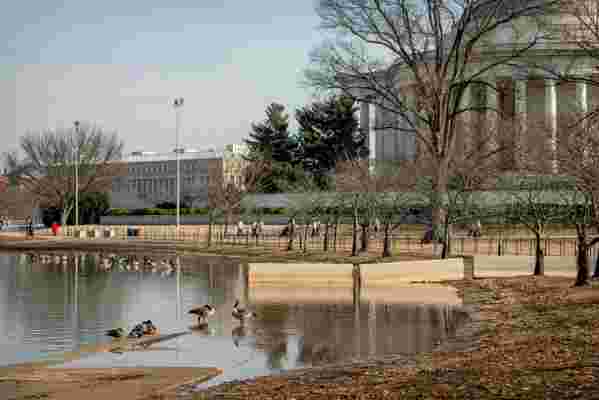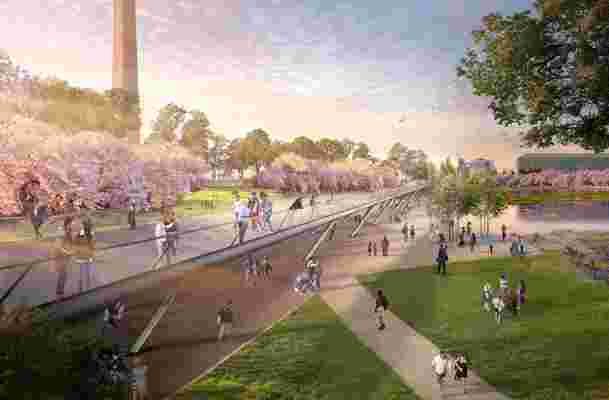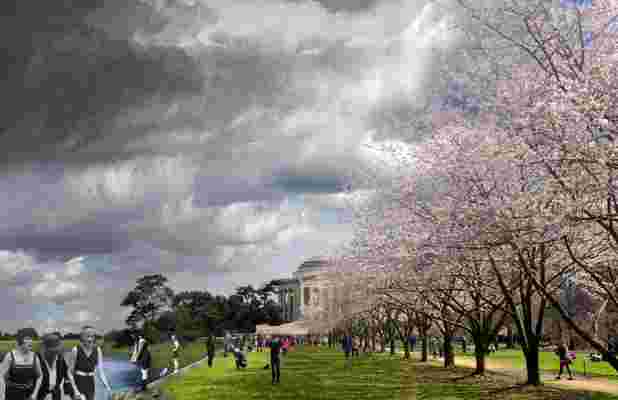See How D.C.’s Iconic Tidal Basin Is Being Reimagined by Five Design Teams
Home to some of the nation’s most iconic monuments, Washington, D.C.’s Tidal Basin—the man-made reservoir adjacent to the National Mall—currently suffers from crumbling seawall infrastructure and twice-daily flooding. Today the National Trust for Historic Preservation; the Trust for the National Mall; the National Park Service; Skidmore, Owings & Merrill; and American Express unveiled the Tidal Basin Ideas Lab to address these issues through design. The Lab has engaged five renowned American landscape firms—DLANDstudio, GGN, James Corner Field Operations, Hood Design Studio, and Reed Hilderbrand—to create proposals to protect and reimagine the site, which includes memorials to Thomas Jefferson, Martin Luther King Jr., and Franklin Delano Roosevelt, as well as 3,000 cherry trees whose blooms are celebrated each year.

Currently, the Tidal Basin suffers from daily flooding and unkempt infrastructure.
“With over 36 million visits annually, the National Mall is the most visited national park in the country,” says Catherine Townsend, president and CEO of its trust. Accessible online, the Ideas Lab is an exhibition that allows the public to give feedback on the five design schemes for the adjacent basin, known as “America’s front yard.” Addressing the apparent immediate needs of the Tidal Basin and considering climate change, visitorship, and use of the basin’s park, the proposals offer diverse solutions for its future, presented digitally by curators Donald Albrecht and Thomas Mellins with the historical narratives that informed them.

An elevated walkway connects the Tidal Basin to the city in the scheme proposed by Reed Hilderbrand.
The proposal perhaps most directly adhering to history is that of Cambridge, Massachusetts–based Reed Hilderbrand. Following the 1902 McMillan Plan’s idea of creating a “Washington Common,” the team took a flexible, yet nonradical approach to preserving the basin, proposing landforms to protect it from daily flooding as well as a series of open lawns, circling pathways, and new cherry groves to allow for additional recreation on-site. Brooklyn-based DLANDstudio, similarly, proposes a land bridge from the Jefferson Memorial to the White House, but takes its phased solution to protecting the shoreline directly into the water via a jetty, weir, and berm.

The DLANDstudio-proposed land bridge between the Jefferson Memorial and the White House.
Seattle-based GGN’s approach is gradual, allowing for bureaucratic project approval timelines in a plan that would be achieved in three stages until 2090. Looking at the basin as an “ecological whole,” says founding partner Kathryn Gustafson, the firm recommends new floodplain forests, tidal marshes and boardwalks, and the introduction of native flowering trees as solutions to naturally curb flooding and allow generational evolution of the site. Also with ecology in mind, James Corner Field Operations sets forth three future scenarios to mitigate rising waters: an earthwork levee to protect the site in its current state, an entropic solution in which nature takes over the site, and a middle way that protects the monuments as garden islands within this natural floodplain.
GGN proposes floodplain forests and tidal marshes as gradual solutions to rising water levels on the site.
Walter Hood of Oakland, California–based Hood Design Studio instead takes a social approach to the site’s challenges, envisioning the Tidal Basin as an opportunity to rebuild an urban ecology through remembrance of its past. Three “anthems” guide this new Tidal Basin: “Tell the Truth!,” “Invention: Making New Things,” and “Let the Waters Be Free.” All replace romantic narratives with true stories of perseverance, resilience, and the values of these wetlands held by indigenous and enslaved peoples. Exploring passive and active technologies, Hood proposes a sustainable future and a new story of the iconic landscape.
At the Tidal Basin, Hood proposes educational opportunities to overtake the more romantic narratives of the site. Here, a proposed group learns about “hush harbors,” wetlands that served as hidden meeting places of worship for enslaved people.
As the public weighs in on the five proposals, the stakeholder team may adopt one, none, or parts of several of the solutions set forth by the design teams. What Hood emphasizes is likely to come into play: The historical significance of this project could be vast if it leads to a national change in approach to waterside green space when it abuts some of our most treasured structures. “Landscape is a medium of exchange between humans and the environment,” he explains. “It can tell a very powerful story.”